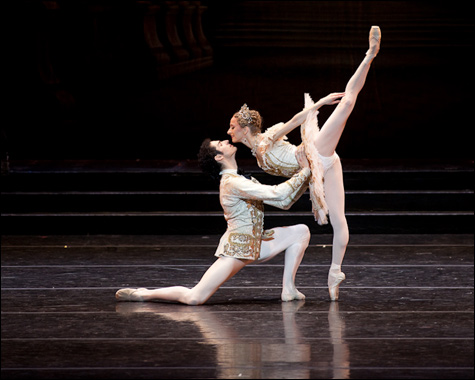
CARLOS MOLINA AND LARISSA PONOMARENKO Good while it lasted. |
The end of an era loomed last Thursday night as Boston Ballet opened
The Sleeping Beauty — what’s likely to be the last story ballet ever to be staged at the Wang Theatre. The company will be moving to the smaller (though by no means small) Opera House next season, and everything will be scaled down a bit. The 3600-seat Wang would be a luxury for any dance troupe, and over the past 15 years or so, Boston Ballet — a bigger and better company than Boston’s size would warrant — has struggled to fill it. Still, the Wang’s opulence and spaciousness — not just on stage but in the lobby areas — will be missed.
The end of another era at Boston Ballet is looming as well. Larissa Ponomarenko made her company debut in Sleeping Beauty in 1993, famously slipping and falling on her derriere as she entered and then getting up and giving an incandescent performance as Aurora. Now she’s dancing in her fifth production of Beauty for Boston Ballet, and it’s hard to imagine there’ll be a sixth. Not that she’s lost much over the past 16 years. She was her usual regal self Thursday night, in the long arch of her phrasing, in the delicacy of her ronds de jambe, in the way she makes you think she’s holding a position longer than she actually does. She was never a virtuoso, and there were reminders of that, though there was also a triumphant glance when, at the climax of the Rose Adagio, she paused unsupported on pointe before taking the English Prince’s hand. More important, over the past few productions — most recently in 2005 and before that in 2001 — she’s never looked like a thirtysomething trying to play Aurora at 20 (or 18, or 16, or however the program has it), and she doesn’t now. She comes out as starry-eyed as if it were her first big party.
Ponomarenko didn’t have to pick herself up off the floor Thursday night, but she did have to dance with two Princes — which is not in the Sleeping Beauty script. Prince #1, Carlos Molina, had given a creditable performance in the second act, holding a steady line in his solo through the balancing and extending and exiting from pirouettes, and in the first part of the third-act Grand Pas de Deux he and Ponomarenko whipped through three snappy fish dives in succession. But as the music for the Prince’s stage-circling manège began, he stepped, stopped, and looked stoically at the audience. Then he acknowledged us with a gesture and walked off with a season-ending injury, torn plantar fascia in the arch of his right foot. Manège music but no manège. The audience, in a show of class, applauded all the same. Ponomarenko entered and did her solo, and then for the finale she was joined by Prince #2, Pavel Gurevich, who had been dancing in the third-act pas de trois and was still wearing that costume. When at the end all the third-act divertissements reappeared, Gurevich’s place was taken by Jared Redick, earlier seen as the Golden Vine Fairy’s attendant and after that in the audience but now back on stage and in the appropriate costume. This is a company that reacts well in adversity: last month, when Josephine Pra hobbled off in the middle of George Balanchine’s Rubies, Tiffany Hedman — who wasn’t even cast in that ballet — got into a costume and finished up without a hitch.